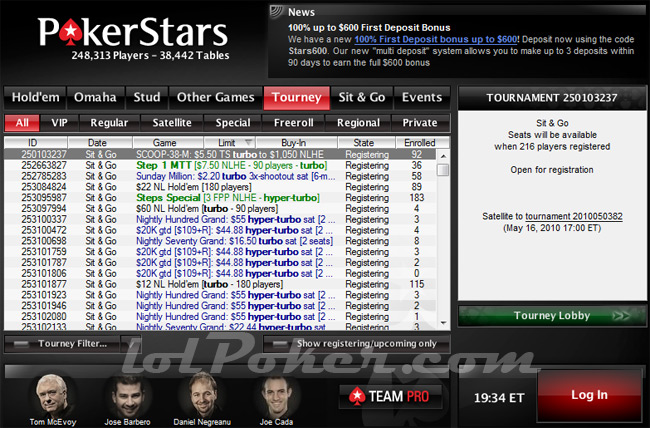Badugi Sit and Go Strategy
A badugi sit and go tournament, also known as sitngo, sit n' go or SNG, is very much like a regular tournament except it is on a much smaller scale. In case you didn't know what a sit and go was, it is basically a small multi-table competition that starts immediately after enough people have registered to join. There is no long waiting time or scheduled event, which is convenient for people who just want to sit down and "go" play a badugi poker in a tournament style. Usually the buy in cost ranges from $1 to a few hundred and will contain tables with full fixed limit rules such as pot limit and half-pot limit. Remember, the strategy is much different than a normal ring game and you can read more articles about different badugi strategies on this site as well.
Since sit and go's tend to go through quickly, opponents should adopt a more aggressive playing style. The size of the blinds usually increase much quicker as well so this is another incentive to become more aggressive and not lose all of your chips due to being too tight. If you have played holdem styled poker, badugi works much the same way when it comes to betting. For example, certain positions on the table must pay a small and big blind. Other positions allow you to act last or be the first to act so this is also important in strategy as well.
Like any tournaments, badugi sit and go's require players to be tight at the beginning. At least this is the proper strategy to use when you first start off. The reason is there are going to be some inexperienced players who will go all-in or will not take the game as seriously. This is more common on multiple table sit and go games. If you are on a single table, play it more conservatively for awhile to allow for these players to "weed" out.
Pay attention to your opponent as well. If many of them are tight, you should be even more aggressive and try bluffing early to steal the blinds and the pot. These players will fold more easily. If you are playing at a single table, every stolen blind adds to your chips while sit and go tournaments themselves do not have too many chips in play. Some of the experts suggest that you should be tighter when the blinds are small and become looser when the stakes get larger. I happen to agree with this because you can give players the impression right at the beginning that you are a conservative player. Then later on in the game, you get more rewards from the greater number of chips and higher blinds. Bluffing tends to work a little better by throwing off some of the those who kept track of your tight game-play at the beginning.
When you are playing tight at the beginning, you should also be watching and taking notes of what the other players are doing. Note if they are loose, tight, aggressive or passive. Tight players tend to fold often, aggressive opponents tend to attack the bet button when they get something good, loose players tend to bet on every starting hand and passive players usually slow-play their hand. The passive players are the most dangerous ones in badugi poker so watch out for them.
Later on in the game, the strategy should be stealing blinds and bluffing more often. This is much more important now than at the beginning since there is more to steal. It is always best to have the chip lead and to use this to your advantage when bluffing players. Players with short stacks will not want to commit to a lot of money unless they have something very good. If they are tight, you should be able to spot this and fold if they suddenly become aggressive.
As I noted earlier, positioning on the table is a big factor in badugi sit and go tourneys. If you are the last to act, watch what the other players are doing on the starting hand or on the draw rounds. If you notice players drawing 2 or more cards, you should attack this since it is likely they do not have such a good hand. You can also semi-bluff if you have a somewhat decent hand. Knocking out more competitors early improves your chances of winning since there are fewer people to play against. If you are first to act, the strategy is to be tight and more conservative. This is advisable since you do not yet have enough information of the rest of the table and what your opponents are holding.
Later on when there are fewer people left, your odds improve. For example, if there are only 3 or 4 players left, the chances of anyone getting a 4 card badugi are slim and this is a time to become looser. You do not want to be too conservative since the blinds will hit you more often and your chip stack will quickly diminish. If you notice these tight players, then by all means be aggressive with them and let them fold on every hand. Watch out if they do call your bet since they might have finally got that powerful hand they were waiting so long for, especially if they stand pat after the starting hand or a single draw round.
The same strategy applies to heads up situations as well. Be even looser here since your odds of winning are nearly 50/50 anyways. Take advantage of tight players and take the blinds when they are very large at this point of the final table. The main goal is to at least make it to the "bubble" and walk away with some kind of prize. Usually, if you make it into the money, you will win enough to cover the costs of the buy-in, plus make a small profit. The goal afterwards is to win.
Typically, these badugi tournaments will last 45 minutes for a single table or up to 2 or 3 hours for multiple table sit and go's. So you will need to get used to the fast pace game. If you are good at quickly reading others, knowing basic badugi rules and strategy, and making quick decisions, you should always be making it to some of the prize money. You will find that these tournaments are actually pretty fun to play whether they are micro-stakes or high limit stakes.


 US Players and Credit Card, BitCoin Deposits Accepted!
US Players and Credit Card, BitCoin Deposits Accepted!


